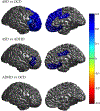Subcortical Brain Volume, Regional Cortical Thickness, and Cortical Surface Area Across Disorders: Findings From the ENIGMA ADHD, ASD, and OCD Working Groups
- PMID: 32539527
- PMCID: PMC8296070
- DOI: 10.1176/appi.ajp.2020.19030331
Subcortical Brain Volume, Regional Cortical Thickness, and Cortical Surface Area Across Disorders: Findings From the ENIGMA ADHD, ASD, and OCD Working Groups
Erratum in
-
Correction to Boedhoe et al.Am J Psychiatry. 2020 Sep 1;177(9):843. doi: 10.1176/appi.ajp.2020.1779correction. Am J Psychiatry. 2020. PMID: 32867522 No abstract available.
Abstract
Objective: Attention deficit hyperactivity disorder (ADHD), autism spectrum disorder (ASD), and obsessive-compulsive disorder (OCD) are common neurodevelopmental disorders that frequently co-occur. The authors sought to directly compare these disorders using structural brain imaging data from ENIGMA consortium data.
Methods: Structural T1-weighted whole-brain MRI data from healthy control subjects (N=5,827) and from patients with ADHD (N=2,271), ASD (N=1,777), and OCD (N=2,323) from 151 cohorts worldwide were analyzed using standardized processing protocols. The authors examined subcortical volume, cortical thickness, and cortical surface area differences within a mega-analytical framework, pooling measures extracted from each cohort. Analyses were performed separately for children, adolescents, and adults, using linear mixed-effects models adjusting for age, sex, and site (and intracranial volume for subcortical and surface area measures).
Results: No shared differences were found among all three disorders, and shared differences between any two disorders did not survive correction for multiple comparisons. Children with ADHD compared with those with OCD had smaller hippocampal volumes, possibly influenced by IQ. Children and adolescents with ADHD also had smaller intracranial volume than control subjects and those with OCD or ASD. Adults with ASD showed thicker frontal cortices compared with adult control subjects and other clinical groups. No OCD-specific differences were observed across different age groups and surface area differences among all disorders in childhood and adulthood.
Conclusions: The study findings suggest robust but subtle differences across different age groups among ADHD, ASD, and OCD. ADHD-specific intracranial volume and hippocampal differences in children and adolescents, and ASD-specific cortical thickness differences in the frontal cortex in adults, support previous work emphasizing structural brain differences in these disorders.
Keywords: Attention Deficit Hyperactivity Disorder; Autism Spectrum Disorder; ENIGMA; Obsessive-Compulsive Disorder; Structural MRI.
Conflict of interest statement
All other authors from the ENIGMA ADHD working group have no conflicts of interest related to this study.
Figures




Comment in
-
Shared or Distinct Alterations in Brain Structure in Disorders Across the Impulsivity-Compulsivity Spectrum: What Can We Learn From Cross-Disorder Comparisons of ADHD, ASD, and OCD?Am J Psychiatry. 2020 Sep 1;177(9):799-801. doi: 10.1176/appi.ajp.2020.20071031. Am J Psychiatry. 2020. PMID: 32867517 No abstract available.
-
The Neuroscientist Comments.Neuroscientist. 2021 Feb;27(1):7. doi: 10.1177/1073858420974344. Neuroscientist. 2021. PMID: 33432887 No abstract available.
References
-
- Faraone SV, Asherson P, Banaschewski T, Biederman J, Buitelaar JK, Ramos-Quiroga JA, & Franke B. (2015). Attention-deficit/hyperactivity disorder. Nature Rev. Dis. Primers, 1, 15020. - PubMed
-
- Antshel KM, Zhang-James Y, & Faraone SV (2013). The comorbidity of ADHD and autism spectrum disorder. Expert review of neurotherapeutics, 13(10), 1117–1128. - PubMed
MeSH terms
Grants and funding
- R21 MH101441/MH/NIMH NIH HHS/United States
- K23 MH092397/MH/NIMH NIH HHS/United States
- K23 MH104515/MH/NIMH NIH HHS/United States
- U54 EB020403/EB/NIBIB NIH HHS/United States
- L40 MH098392/MH/NIMH NIH HHS/United States
- U01 DA041148/DA/NIDA NIH HHS/United States
- T32 MH067763/MH/NIMH NIH HHS/United States
- R01 MH086654/MH/NIMH NIH HHS/United States
- U01 MH099059/MH/NIMH NIH HHS/United States
- R61 MH121640/MH/NIMH NIH HHS/United States
- G0300189/MRC_/Medical Research Council/United Kingdom
- R01 MH062873/MH/NIMH NIH HHS/United States
- HHSN271200800009C/DA/NIDA NIH HHS/United States
- UL1 TR001863/TR/NCATS NIH HHS/United States
- R01 MH081864/MH/NIMH NIH HHS/United States
- R21 MH093889/MH/NIMH NIH HHS/United States
- KL2 TR000069/TR/NCATS NIH HHS/United States
- K23 MH082176/MH/NIMH NIH HHS/United States
- R01 MH085328/MH/NIMH NIH HHS/United States
- P30 HD024061/HD/NICHD NIH HHS/United States
- R01 MH078160/MH/NIMH NIH HHS/United States
- R01 MH081803/MH/NIMH NIH HHS/United States
- R01 MH111794/MH/NIMH NIH HHS/United States
- R01 MH099064/MH/NIMH NIH HHS/United States
- R01 MH085900/MH/NIMH NIH HHS/United States
- M01 RR000052/RR/NCRR NIH HHS/United States
- R33 MH107589/MH/NIMH NIH HHS/United States
- UL1 TR000067/TR/NCATS NIH HHS/United States
- R00 MH091238/MH/NIMH NIH HHS/United States
- P41 RR015241/RR/NCRR NIH HHS/United States
- K23 MH087770/MH/NIMH NIH HHS/United States
- WT_/Wellcome Trust/United Kingdom
- R01 MH107419/MH/NIMH NIH HHS/United States
- T32 MH073517/MH/NIMH NIH HHS/United States
- R01 MH115357/MH/NIMH NIH HHS/United States
- R01 NS048527/NS/NINDS NIH HHS/United States
- R21 TR003103/TR/NCATS NIH HHS/United States
- R01 MH083246/MH/NIMH NIH HHS/United States
- R01 MH094639/MH/NIMH NIH HHS/United States
- K23 MH115206/MH/NIMH NIH HHS/United States
- K99 MH091238/MH/NIMH NIH HHS/United States

